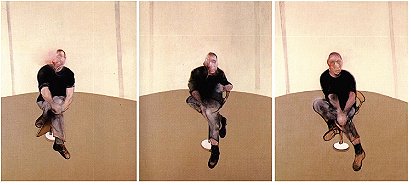Francis Bacon : Study for a Self-Portrait—Triptych
Study for a Self-Portrait—Triptych, 1985–86 is a triptych painted between 1985 and 1986 by the Irish born artist Francis Bacon. The work is an acknowledgment and examination of the effect of age and time on the human body and spirit, and was painted after a period when many close friends of the artist died. Although widely considered a masterpiece and one of Bacon's most personal works, the triptych is at the same time one of his least experimental and most conventional paintings. Bacon believed that the fatigue of old age and the complications of fame lead him to appreciate simplicity as a virtue of its own, a sentiment which he attempted transferred into his work.[1] The only full-length self-portrait that Bacon made, the triptych has been described by the art critic David Sylvester as "grand, stark, ascetic."[2]
A number of Bacon's closest friends died in the years before he began the triptych, and their loss weighed heavily on the artist.[3] In 1979, the proprietor of Soho's Colony Room, Muriel Belcher, passed, while in 1981 Bacon's youngest sister Winifred died. During the 1970s, he lost many of his friends, including his lover George Dyer. In an interview with David Sylvester in the early 1980s, he conceded that his friends "have been dying around me like flies and I've had nobody else to paint but myself...I loathe my own face, and I’ve done self-portraits because I’ve had nothing else to do".[3]
The style of the work departs from Bacon's usual format. It is more symmetrical and places the figures more centrally; previous triptychs typically positioned the figures in the outer panels slightly towards the edge. The three panels share a cool, light-brown surface, while its figures are unusually diminished in size.[4]
Study for a Self-Portrait continues a painterly motif that Bacon began early in his career: a spatially uniform and simple background (although the back line is curved in the center panel, a device generally only seen in much later work). Here, the figures are held together by pairs of vertical blinds in the background of each frame. In contrast to most of Bacon's works, the background in this work references contemporary art, drawing on the stillness of Barnett Newman's Voice (1950), while the elegance of the figures echoes Henri Matisse's Music.
A number of Bacon's closest friends died in the years before he began the triptych, and their loss weighed heavily on the artist.[3] In 1979, the proprietor of Soho's Colony Room, Muriel Belcher, passed, while in 1981 Bacon's youngest sister Winifred died. During the 1970s, he lost many of his friends, including his lover George Dyer. In an interview with David Sylvester in the early 1980s, he conceded that his friends "have been dying around me like flies and I've had nobody else to paint but myself...I loathe my own face, and I’ve done self-portraits because I’ve had nothing else to do".[3]
The style of the work departs from Bacon's usual format. It is more symmetrical and places the figures more centrally; previous triptychs typically positioned the figures in the outer panels slightly towards the edge. The three panels share a cool, light-brown surface, while its figures are unusually diminished in size.[4]
Study for a Self-Portrait continues a painterly motif that Bacon began early in his career: a spatially uniform and simple background (although the back line is curved in the center panel, a device generally only seen in much later work). Here, the figures are held together by pairs of vertical blinds in the background of each frame. In contrast to most of Bacon's works, the background in this work references contemporary art, drawing on the stillness of Barnett Newman's Voice (1950), while the elegance of the figures echoes Henri Matisse's Music.
 Login
Login


